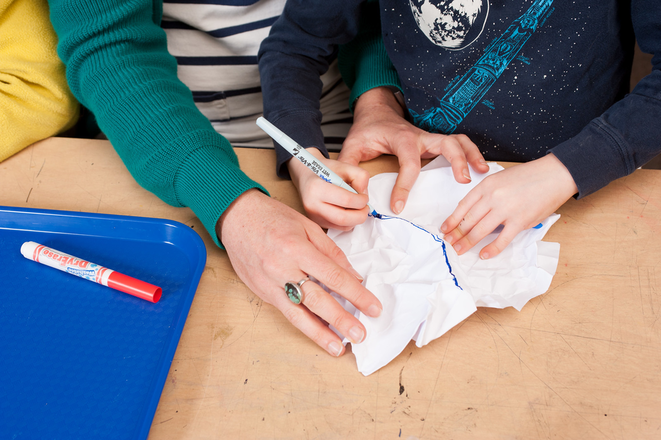
Create paper mountains to learn about land and water!
"Exploring Earth: Paper Mountains" encourages participants to explore the way the shape of the land and the pull of gravity influence how water moves over Earth. By making unique mountain models from crumpled paper and watching how water moves across them, participants can act as Earth scientists, using their observations to make predictions about the future of our planet.
The shape of the land and the pull of gravity both influence how water moves over Earth. The paper mountains in this activity behave like a miniature model watershed. The way the marker ink moves with the water represents how water can carry surface particles through a watershed. A watershed is all of the land that drains runoff into a shared body of water.
Rainwater and snowmelt pick up and carry whatever is on the land—such as trash and debris on streets, exposed soil from landslides or construction, or pollution from mines or farms—to the nearest body of water. What happens upstream always influences the water quality and processes downstream. This activity lets you explore how this process works!
What you will need:
Copy paper
Washable markers
Dropper bottles/an eyedropper
Water
Step 1.
Crumple up a piece of paper and gently open it most of the way. It should still show ridges (high points) and valleys (low points).
Step 2.

Choose one of the ridges and color the whole ridgeline with a washable marker. Use lots of ink! Place the paper on an absorbent microfiber towel.
Step 3.

Make a prediction. If water fell on the ridge you just colored, where would it go? What would happen to the ink? Now, test your prediction. Use the dropper to place water onto the peak, simulating a rainstorm. Was your prediction correct? Were you surprised by anything?
Step 4.

Repeat this experiment and make more ridges on your crumpled paper. Do your predictions change as you make and observe more simulated rainstorms?
In this activity, you made predictions and observations about how water would behave on your model mountains.
Scientists use observations to make predictions about the future of our planet. Understanding our planet’s interconnected processes can help researchers make predictions about global climate, weather patterns, natural disasters, and better understand how Earth will change in the future.
Scientists use ground-based instruments here on Earth, as well as satellites and other aircraft, to study our planet. NASA observes Earth from above to learn more about how Earth systems are changing, and how science can benefit society.
Check out the full version of this activity here and find out how to build a simple rain gauge at home and share your data with researchers who collaborate with NASA!